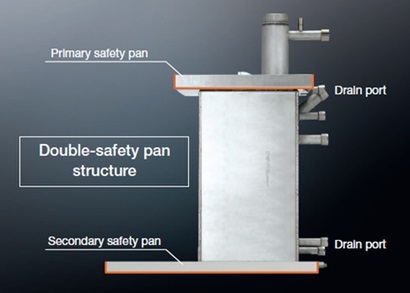Features for PCU-R Series
Stability and precision at the highest level of the class
Compatible with a wide range of applications in regulating the temperature of the circulating water.
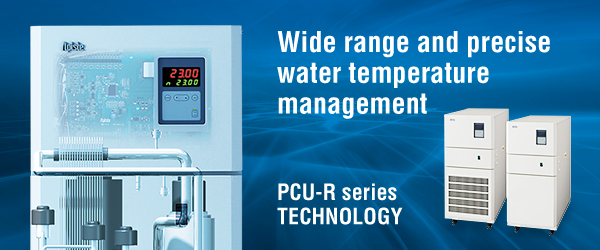
High Precision and High Stability
Newly developed freezing cycle "Triple valve control" and control algorithm "Parallel task control"
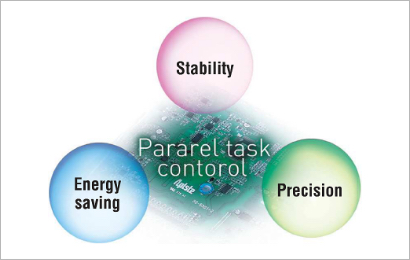
Equipped with Apiste's unique refrigerating cycle "Triple valve control" containing three electronic control valves. Always monitors refrigerant temperature, pressure, and circulating temperature. Newly developed algorithm "Parallel task control", based on information measured by various sensors, performs PID control of independent three electronic control valves and compact control heater in parallel and in high precision. Apiste's unique refrigerating technology, which varies cooling capacity in a wide range from 0 to 100% without stopping the compressor, has realized "ultra high precision" "high stability" "wide temperature control range" and "energy saving" which used to be difficult by conventional inverter control and hot gas control.

Three types of control mode
Operation pattern is selectable from three types of control mode in match with installation environment and versatile applications. Efficient and optimum performance can be fully demonstrated conforming to purpose of application. High-precision mode infinitely good in precision, eco mode in pursuit of energy efficiency, and normal mode with high stability are available.
[ Normal mode ]
Control mode putting emphasis on responsiveness and stability. When control shifts either to cooling side or heating side, stability can be maintained by its following capability.
[ Eco and high-response mode ]
Control mode putting emphasis on energy saving and responsiveness.
In cooling, operation at low power consumption is enabled without using a heater.
This mode is also effective when load fluctuation and disturbance are great.
[ High-precision mode ]
"Control mode effective when control of higher precision is required.
The true value is demonstrated in any temperature range from -10°C to 80°C."
Wide range from -10 ℃ to 80 ℃
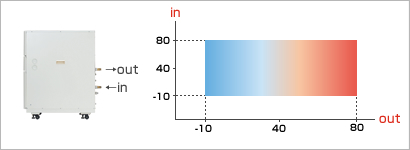
Temperature control range by Apiste's parallel task control is a wide range from -10°C to 80°C. Continuous operation is enabled in all ranges without stopping the compressor. There is no instability by ON/OFF control, and high stability and high precision are always realized in any temperature range.
Resistant to high temperature circulating water return and load fluctuation
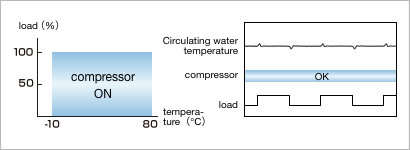
If the circulating water returning to the chiller unit becomes hot due to the load fluctuation of the equipment, the compressor may be turned off and the cooling function may not work in a general chiller. Apiste's parallel task control can control a sudden rise in circulating water without stopping the compressor.
Energy saving and heater capacity -90%
Heater capacity was reduced by 90% in comparison with conventional freezing cycle 100% + heater control, and realized the energy saving. 15. Wide range from -10°C to 80°C
New structural design that pursues high reliability

Bottom tank structure
All the parts along circulating water route are installed at the top of tank, which is a structural design unique to Apiste. We adhered to the development of the top installation which is ready for accidental leakage. Newly developed high performance pump pumps up circulating water in the tank to the top, and feeds reliably up to the equipment.
Double tank structure for energy saving and stability

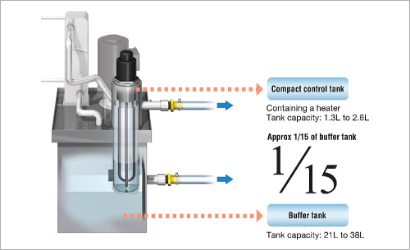
The tank in chiller unit has a double-tank structure consisting of buffer tank and compact tank for control. Circulating water contained in buffer tank is pumped up and cooled by the cooler. Then it is sent to the compact tank for heating control. Heating control does not involve all circulating water in the tank, but only circulating water in the compact tank, which enables drastic energy saving. In addition, instability by irregular heating is eliminated, and high precision and stability are realized.
Cavitation preventing function
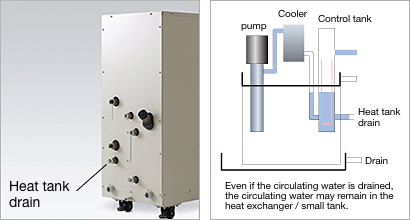
The phenomenon called "Cavitation" may occur in the maintenance of chiller unit. Even though circulating water is drained from the chiller unit, circulating water remains in the heat exchanger, heater tank, and equipment on load side, and bubbles remain in the circulating route when circulating water is fed again, and pressure from the pump is not transmitted. It is naturally impossible to send circulating water. All models of PCU Series are equipped with heater tank drain port for draining this residual water. It is a safety function when feeding water again after drained circulating water.
One-way exhaust structure (air cooling type)
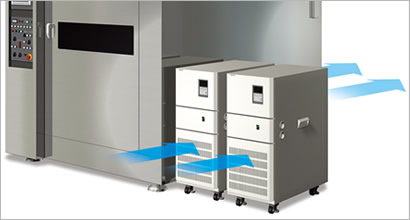
The air-cooling type is designed so that the intake / exhaust paths for heat exchange are in the front and back of the main unit. Unlike the case where the intake and exhaust ports are on the side of the main unit, it is also possible to arrange multiple units closely. This saves space.
Abundant external input / output functions
"Equipped with various external input / output functions as standard to support various external devices and equipment.
It can be used for all purposes without adding new functions."

1. Error output

Equipped with non-voltage contact output with maximum load current of AC250V 2A. It can be output to the outside when an alarm occurs. Not only can you communicate with the PLC, but you can also control patrol lamps and buzzers.
2. Various circulated water alarm output

I would like to pay close attention to the temperature control of circulating water. In the PCU series, warning values and caution values can be set in addition to the temperature upper and lower limit settings. Detects the temperature change of circulating water and reliably outputs it to the outside. Realizes complete temperature control of circulated water.
3.Operation stop output
Check the operation / stop of the chiller. It can be used as a confirmation signal when controlling the operation of the chiller from the outside, and it can also be notified by a lamp of the operating status of the chiller.
4. Automatic water supply valve output

Equipped with an output for a water supply valve that can automatically supply water to the chiller body. It is possible to save the trouble of supplying circulating water. The three-stage float sensor installed in the chiller unit tank detects full water, water supply, and water shortage, and outputs to the external water supply valve when water is supplied. The water supply valve can be turned ON / OFF, and automatic water supply is possible easily.
5.External temperature control

Equipped with an external temperature control input terminal as standard. Normally, the circulating water temperature is measured at the circulating water outlet in the chiller body, but the temperature can be controlled by an external sensor by switching. It supports primary PID control by the circulating water temperature of the work and cascade control by the temperature of the related parts of the work.
Primary PID control
The chiller unit is controlled to keep the temperature of circulating water near the work constant. The temperature of the circulating water is controlled directly to provide a stable control system, but the response to the disturbance is slow and the corrective action is limited.

Cascade control
In cascade control, the temperature of the object (PVm) is compared with the set temperature of the object (SVm), and the set temperature of the circulating water (SVs) is determined. Therefore, the temperature fluctuation due to disturbance is controlled quickly.

6. Emergency stop / alarm reset input
Equipped with an emergency stop input just in case. The chiller can be forcibly stopped by an external signal. It is possible to link the water leak sensor installed separately and the emergency stop button installed on the controlled device. E-99 is displayed at the time of emergency stop input and can be confirmed as a history. It can also be used by switching to the alarm reset input if necessary.
Emergency stop input from external devices such as leak detection sensor, emergency stop button, etc.
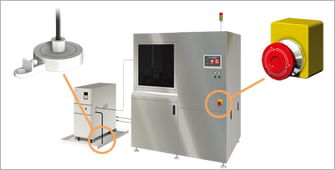
Emergency stop input can be switched to alarm reset input
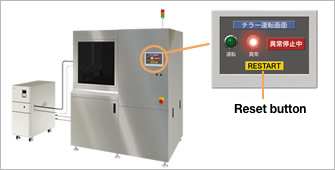
7.External operation / stop input
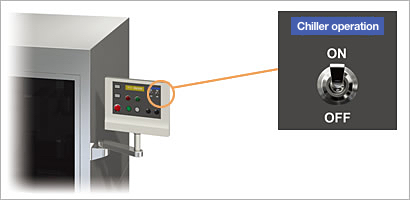
Equipped with an external control input terminal that can be used to start and stop the PCU body from an external device. Since it has a dedicated circuit, it can be operated from the outside simply by preparing the contact signal. When used in combination with the operation / stop output, a higher and more reliable external control can be realized.
Supports data communication with PLC

Equipped with RS-232C as standard, which allows remote control and error code identification from the equipment.
External remote control / error code identification
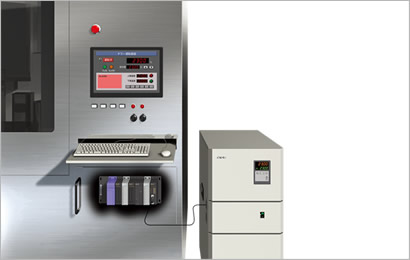
Change the control settings and output settings from the device side. The settings can be changed according to the situation at the site, enabling optimal control. It is also possible to identify up to 31 error codes that the PCU unit has.
[ Communication items list ]

| Control settings | Timer / output setting | Initial setting | Communication settings | Cascade control setting |
|---|---|---|---|---|
| Name | Name | Name | Name | Name |
| Control setting mode | Alarm settings | Digital filter | communication speed | Control type |
| Control mode setting | Water temperature upper limit alarm | Number of display digits | Data length | Cascade scaling upper limit setting |
| AT startup screen | Water temperature warning alarm | Key lock setting | Key lock setting | Cascade scaling lower limit setting |
| Proportional band (P) | Water temperature lower limit alarm | Standby mode Yes / No |
Stop bit length | Secondary side auto tuning setting |
| Integration time (I) | Water temperature caution alarm | Password setting | BCC check function | Secondary side P value setting |
| Derivative time (D) | Water temperature lower limit alarm | Operation signal enable / disable | Communication address | Secondary side I value setting |
| Control water temperature (set value) | Delay time | External temperature input | Response delay time | Secondary D value setting |
| Water valve / Operation output setting |
Anti-freezing operation | Secondary side digital filter setting | ||
| ON timer | Main expansion valve Initialization interval |
Secondary side bias correction | ||
| OFF timer | Secondary gain correction |
[ List of communication items ]

| Driving mode | Error history | Custom settings | Communication only The parameter |
||
|---|---|---|---|---|---|
| Name | Name | Name | Name | Name | Name |
| Error display | Compressor high pressure | Heating expansion valve | Error history this time | Emergency stop / alarm Reset input setting |
PV value input |
| Control water temperature (During measurement) |
Compressor high pressure | High pressure switch | Error history 1 | Circulating water flow rate Alarm settings |
Alarm reset |
| Outside temperature | Pump operating time | Compressor protection thermostat |
Second error 2 | Bias correction | Run / stop |
| Control water pressure | Compressor discharge temperature | For full water Float switch |
Error history 3 | Gain correction | Operation status check |
| Cooling water temperature | Compressor suction temperature | For water supply Float switch |
Auto / Manual setting |
Main valve Initialize |
|
| For heating PID output | Heater overheat prevention temperature | For water shortage Float switch |
PV value communication Timeout setting |
||
| Cooling PID output | Main expansion valve | Emergency stop input | Fixed heater value setting | ||
| Heater current value | Cooling expansion valve | ||||
We're here to give you quick answers to your questions.

